Motorhome inverters are rarely fitted as standard in motorhomes. This means most newcomers to motorhomes do not know what they are or if they need one.
Do I need a motorhome inverter is a common question in our forums?
What is a Motorhome Inverter?
If I had to describe an inverter to a child, I would say something like;
The electricity we get from the motorhome’s batteries comes out in a straight line, very simple and direct.
But some of your gadgets and appliances, like your Mum’s hair-straighteners or a games console, need electricity that moves in a wavy-line.
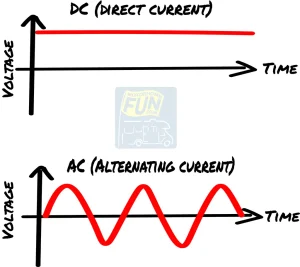
Think of an inverter as a magical box in your motorhome. This magic box takes the straight-line of electricity from the motorhome’s batteries and changes it into the wavy-line electricity you get from the plug sockets at home..
To an adult then. At its core, an inverter is a power converter that changes direct current (DC) to alternating current (AC).
The batteries in your motorhome store power as DC, which is a problem if you have appliances and electronics that will only run on AC.

If you are on hookup, plugged in on a campsite, you don’t need a Motorhome inverter because you already have AC power. Plug in a games console or a hair-dryer into and it will work.
If you are on a rally field or you are wild camping with no hookup, those three-pin plugs in your van will be dead. You will have to rely on the 12volts that your battery produces.
Not everyone needs or wants an inverter
There’s a dedicated group within our motorhome community who prefers to sidestep the need for an inverter altogether, ensuring every device operates on 12 volts.
It’s a workable strategy—12v TVs and laptop chargers are readily available.
The motive behind this choice isn’t just about avoiding the purchase of an inverter. The core reason lies in efficiency: inverters, by design, consume more battery power than they need to.
They nibble away at your stored energy, even when idle, taking a bit of your valuable power to sustain themselves. Keeping an inverter on means it’s quietly sipping electricity even with nothing even plugged in.
Why would I need a Motorhome Inverter?
Historically, the need of ladies (mostly) to use a hairdryer off-grid was a main reason many opted for an inverter.
While the market is flooded with 12V hairdryers, the consensus within the Funster community is clear—they are useless. So people need a system that allows them to use a powerful mains-powered dryer.
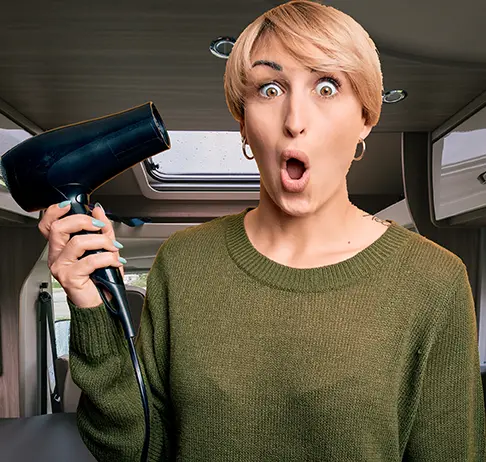
Meanwhile, the increasing popularity of eBikes is leading to a higher demand for motorhome inverters. This is because eBike chargers often need 240V to operate effectively.
As a result, whether you need to power a hairdryer or charge your eBike while away from a standard power source, an inverter has become a crucial tool.
What type of Inverter will I need
So you’ve decided you want one, now you have another decision to make. Broadly, there are two types. Modified sine wave and Pure Sine Wave.
Both types turn our battery power into that nice wave form electricity we enjoy at home. However, one of them does it much better than the other.
Modified Sine Wave
On our forums over the years, people would agonise over which type to buy. The Modified Sine Wave makes decent electricity, but staying with the layman’s terms, it’s a bit lumpy. It’s great for kettles, fans and toasters but can mess with more sophisticated items like laptop chargers, electric toothbrushes, printers and some makes of CPAP machines.
Pure Sine Wave
Pure sine wave machines do everything that a modified sine will do and because the electricity is delivered in a much smoother wave, all of those sensitive items work just like they would at home.
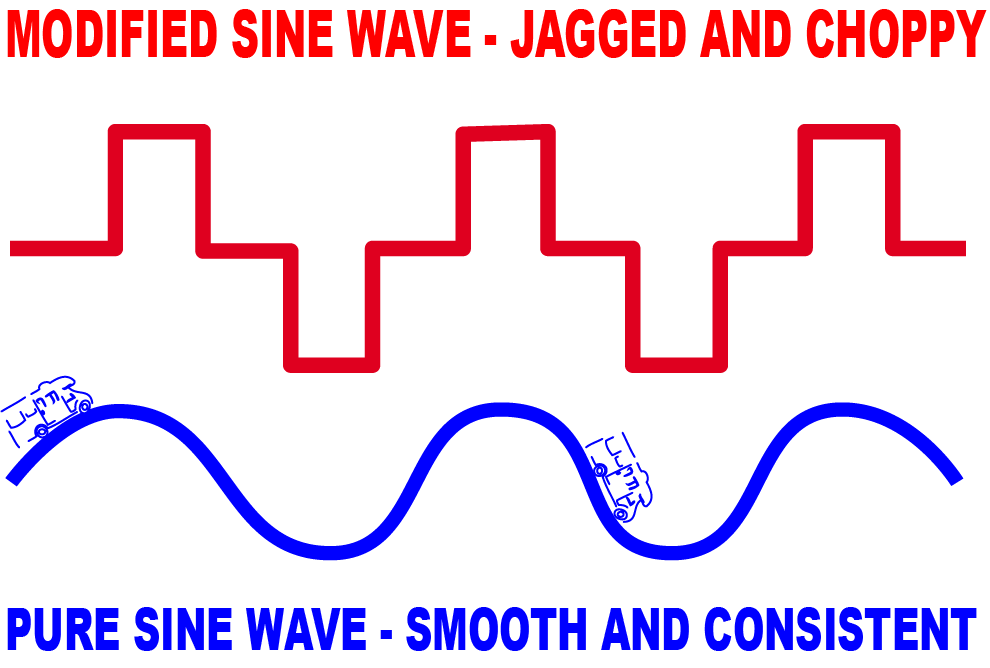
So why does anyone bother with Modified
Well, Modified Sine Wave inverters are much cheaper and much more common, they still are. But Pure Sine are now costing much less than they used too, so given how much better they are, this choice is an easy one.
Price always was the big difference, but these days unless you are really counting the pennies, buy a Pure Sine Wave Inverter.
Right, I’ll buy one then
OK, but before you do, there are a few things to consider.
What Size inverter do I need
Selecting the appropriate inverter size is important. Some just buy the biggest they can afford, while others will pop into Halfords and buy something that works from the cigarette lighter. Don’t do either of these things.
It’s not just about ensuring you have enough power for your devices; it’s about efficiency and battery health. A Motorhome inverter that’s too small just will not handle the load of your appliances, leading to power interruptions or damage to the inverter.
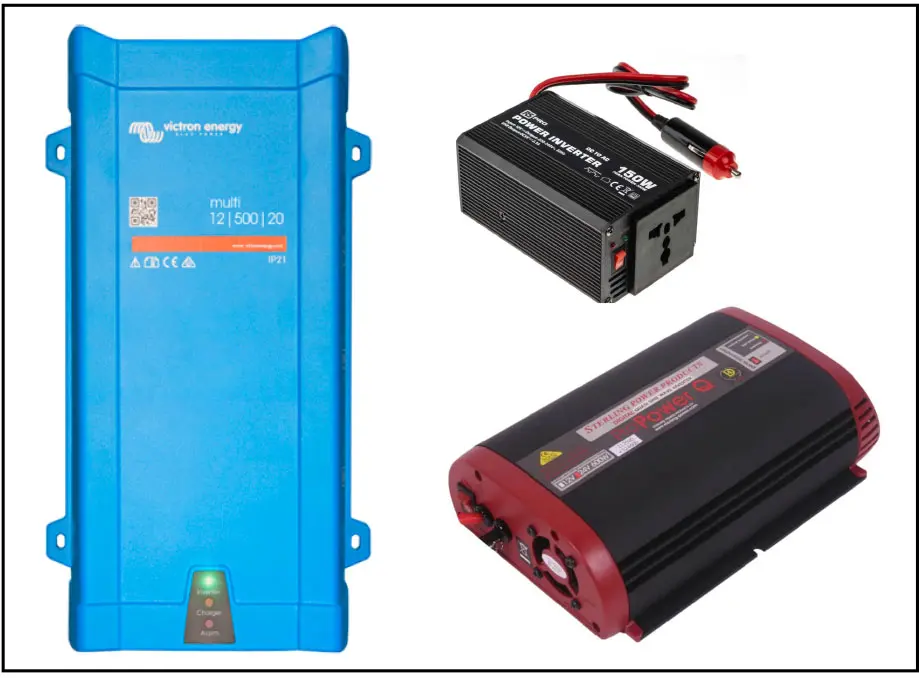
On the flip side, an overly large inverter can unnecessarily drain your batteries, as larger inverters consume more power even when idle.
The key is to calculate the total wattage of the devices you plan to use simultaneously; then add a bit of a buffer for safety and future needs.
This balance ensures you have sufficient power without putting undue strain on your battery system, making your off-grid experiences both reliable and enjoyable.
I know from bitter experience that if the hairdryer doesn’t work in the morning, moans about it will punctuate my whole day!
Bells and Whistles
Some inverters, especially the modified sine are basic and come with very few options. The best you might hope for is an alarm to let you know your battery is getting very low.
Spend a bit more though, and the added bells and whistles can come in very handy. These might include;
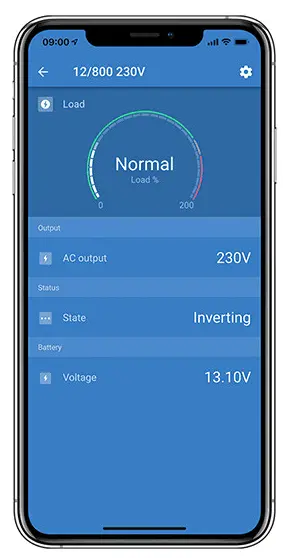
Bluetooth Connectivity
This connects with an app on your smart phone allowing you to easily control the inverter from your captain’s chair without being a gymnast and squeezing into the cupboard it’s fitted into.
Remote switches
Remember that the inverter is sipping power, even when it is not being used, so a hard-wired switch placed in a convenient position to remind you it is on and enable you to turn it off.
Uninterrupted power supply
You can but an inverter with a special feature called UPS (uninterrupted power supply). This smart device can tell when you’re hooked up to the mains and use the power from it.
However, if, like on a lot of campsites, your mains power trips or goes missing, the inverter instantly switches to using battery power without missing a beat. This means your gadgets never lose power, and your TV soaps or sports are never interrupted.
Battery Charging
Another option is an inverter charger. This handy device does two things at once: It’s an inverter as above but when you’re on hookup, it also professionally stage charges your motorhome’s batteries.
Fitting
We won’t go into any detail here. Power produced by the battery, and inverter, has the potential to be extremely dangerous. So if you know what you’re doing, you won’t need any instructions from me. If you have no idea and electricity is a mystery, here are a few experts who will help.
Here are a couple of Installers who will also give you a MotorhomeFun Discount
Vanbitz. Taunton Off Grid Solutions Wantage and Rhino Installs Preston
The Takeaway
The increasing popularity of eBikes has changed the way we think about power on the go, leading to a higher demand for inverters. This is because eBike chargers often need 240V to operate effectively.
As a result, whether you need to power a game station, a toothbrush, hairdryer or charge your eBike while away from a mains hookup, a Motorhome inverter has become a crucial tool.

